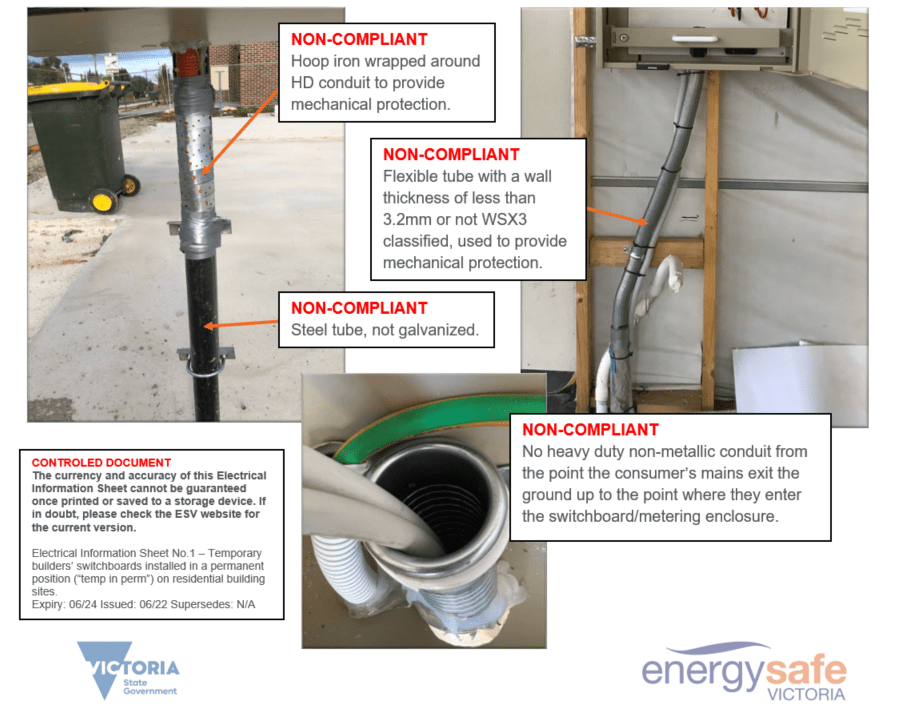Temporary builders’ switchboards installed in a permanent position on residential building sites
Energy Safe Victoria has become aware of a trend of non-compliant underground consumer’s mains being installed on residential construction sites.
The Electricity Safety (General) Regulations require
- underground consumer’s mains installed on a construction site to be mechanically protected up to and into the switchboard/metering enclosure
- any underground consumer’s mains installed on a construction site that exit the ground to enter into a switchboard/metering enclosure must:
- be double-insulated up to the first protective device within the switchboard or metering enclosure
- be enclosed in compliant heavy duty non-metallic conduit from the point they exit the ground up to the point at which they enter the switchboard/metering enclosure
- be provided with additional mechanical protection from the point they exit the ground up to within 100mm of the switchboard/metering enclosure that is constructed of either:
- a galvanized steel tube with a wall thickness of at least 3.2mm
- a 1.6mm thick or greater, sheet steel cover with an unsupported width not exceeding 100 mm.
Examples of non-compliant installations on residential construction sites
Background
In 2019 in response to a spate of dangerously unsafe temporary builders’ switchboards installed in a permanent position (often referred to as a “temp in perm”) that were identified on numerous residential building sites across Victoria, new rules were inserted into the Electricity Safety (General) Regulations.
Energy Safe audits have identified that three years on, Registered Electrical Contractors (RECs), electrical workers and licensed electrical inspectors (LEI) still do not have a good understanding of these requirements.
The relevant rules
Regulation 214 of the Electricity Safety (General) Regulations
This rule requires that:
- any switchboard or metering enclosure (other than a free-standing enclosure) installed on a construction or demolition site must be securely attached to a pole, post, wall or other structure that is rigid and secure
- any free-standing switchboard or metering enclosure installed on a construction or demolition site must be securely fixed in place
- any underground consumer’s mains that enter into a switchboard or metering enclosure installed on a construction or demolition site must:
- from the point at which it exits the ground up to the point at which it enters the enclosure, be enclosed in compliant heavy duty non-metallic conduit
- from the point at which it exits the ground up to a point that is within 100 millimetres of the point at which it enters the enclosure, be provided with additional mechanical protection that is of a construction that meets the mechanical protection classification of WSX3 as specified in Appendix F of AS/NZS 3013.
Australian standards
The Australian standard AS/NZS 3013:2005 sets out the classification of the fire and mechanical performance of wiring system (‘WS’) elements.
Appendix F of AS/NZS 3013 requires, to achieve a WSX3 classification, a wiring system such as consumer’s mains installed in compliant heavy duty non-metallic conduit must have either:
- an additional 1.6mm thick sheet steel coverage with an unsupported width not greater than 100mm
- be enclosed by a galvanized medium steel tube with a wall thickness of at least 3.2mm as specified in table 2.2 of AS 1074.
The Australian standard AS 1074:1989 specifies requirements for steel tubes and tubulars.
| Nominal size (DN) of the steel tube | Wall thickness (mm) of the steel tube |
|---|---|
| 32 – 40 | 3.2 |
| 50 – 65 | 3.6 |
| 80 | 4.0 |
| 100 | 4.5 |
Other methods of compliance with WSX3 classification can include using wiring enclosures or wiring systems tested to and passing the requirements of AS/NZS 3013, or by using very heavy-duty conduit complying with AS/NZS 2053.
Other considerations
Three elements of the rules and regulations need to be taken into account by the REC, electrical worker and LEI when installing and inspecting a switchboard on a residential building site:
- The construction of the consumer’s mains and that the switchboard/metering enclosure is securely attached to a pole, post, wall or other structure
- The construction of underground consumer’s mains within a structure
- The protection of wiring systems near building surfaces (the '50mm rule').
The requirement for consumer’s mains and switchboard/metering enclosure on construction and demolition sites are called up at regulation 214 of the Electricity Safety (General) Regulations 2019.
The requirement for the construction of underground consumer’s mains within a structure are set out at regulation 224 of the Electricity Safety (General) Regulations 2019.
The requirement in regards to protection of wiring systems near building surfaces are covered in the following clauses of AS/NZS 3000:2018, the Australian/New Zealand Wiring Rules:
- clause 3.9.4, Protection against mechanical damage
- clause 3.9.4.2 Wiring systems near building surface
- clause 3.9.4.3.2 Protection required
- clause 3.9.4.4 Protection methods.
Legislation
Electricity Safety (General) Regulations 2019
You can download these regulations free of charge: Electricity Safety (General) Regulations 2019 (Legislation Victoria)
Electricity Safety Act 1998
You can download this Act: Electricity Safety Act 1998
This Act contains, in section 3, definitions relevant to the Electricity Safety (General) Regulations.
Date: 03/12/2025 3:56
The material in this print-out was accurate at the time of printing.
Reviewed
